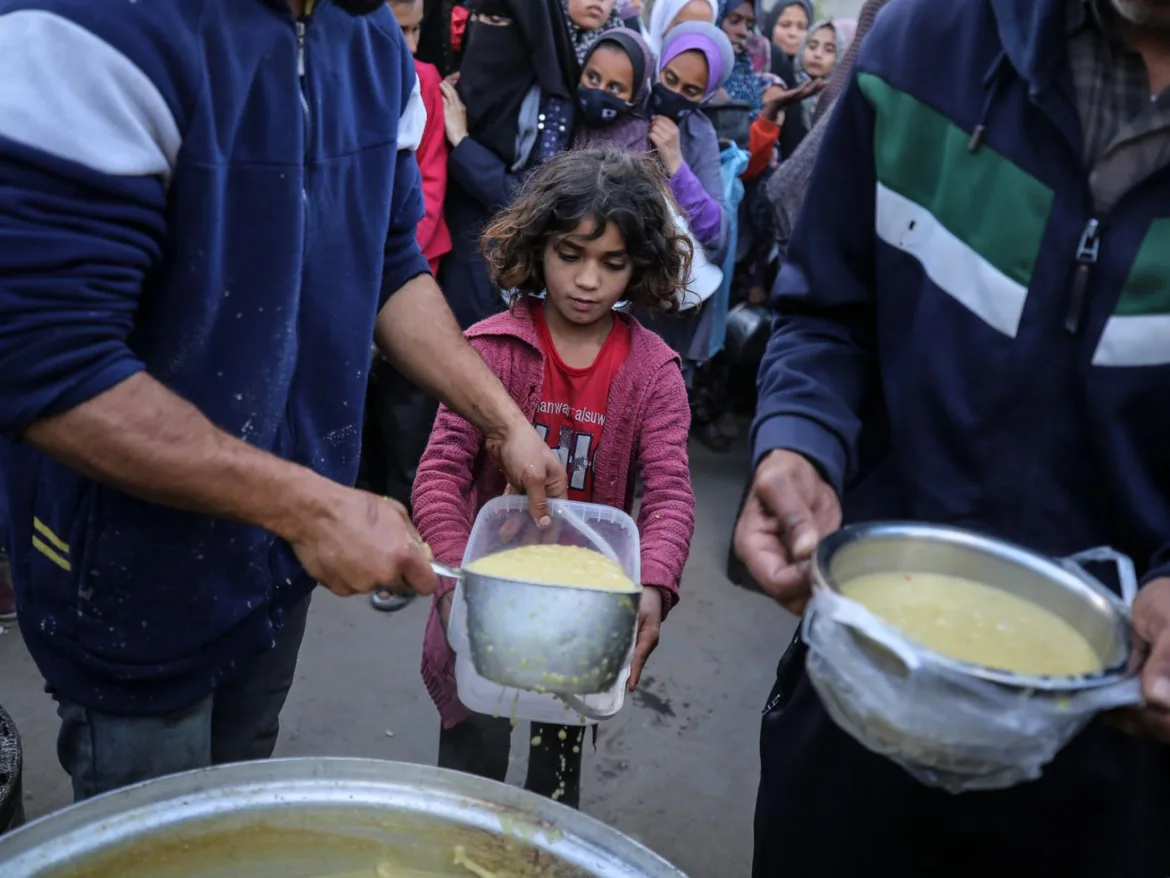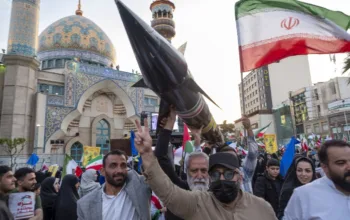Everyone in Gaza is facing crisis levels of hunger. It’s entirely preventable.
Every resident of Gaza is at risk of crisis levels of food insecurity — and half are at risk of famine.
Yes, you read that right: Nearly six months into the Israeli invasion after the October 7 attacks, every single Gaza resident is at risk of at least crisis-level food insecurity — defined as households having high levels of malnutrition or resorting to “irreversible” coping mechanisms like selling livestock or furniture to afford even an insufficient diet.
It’s a crisis that has unfolded at a speed utterly unprecedented this century — and also one that was repeatedly predicted and entirely avoidable if Israel were not placing severe restrictions on aid.
It comes as the United Nations Security Council vetoed yet another draft resolution calling for an immediate ceasefire on Friday that, for the first time since the start of the war, had the backing of the US.
The Integrated Food Security Phase Classification (IPC), the primary organization tracking food insecurity worldwide, defines five levels of food insecurity: Phase 1 (minimal), Phase 2 (stressed), Phase 3 (crisis), Phase 4 (emergency), and finally, Phase 5 (famine). More than 1 million people in Gaza could face famine by mid-July if a Rafah escalation occurs, according to a new IPC report.
Soon, “more than 200 people [will be] dying from starvation per day,” a UN aid spokesperson told reporters last week.
/cdn.vox-cdn.com/uploads/chorus_asset/file/25350437/oyk9t_famine_is_looming_in_gaza__1__720.png)
Prior to the October 7 attacks on Israel, the Israeli government tightly controlled the flow of goods entering Gaza, having ramped up oversight since Hamas took over the territory in 2007 and created what many international law experts call a de facto occupation. Then, two days after the Hamas attacks, Defense Minister Yoav Gallant ordered a “complete siege” on Gaza, barring fuel, food, water, and electricity from entering the territory. (Siege warfare against an occupied territory is illegal under international law.) While Israel later allowed limited supplies, including food and medical aid, to enter Gaza, and minimal sources of clean water have been restored, none of these necessities are near the level that they were before the war started.
Though the Israeli government, through its official channels and to Vox, denies the possibility of famine in Gaza and disputes numbers released in the IPC report, facts on the ground show increasing desperation for the people of Gaza.
“If you cut off food, water, and power to a population that is fully dependent on importing, this is what you get,” Jeremy Konyndyk, president of Refugees International, told Vox in an interview. “I mean, that is just math.”
Experts have warned about this crisis since the beginning of the war
Around 80 percent of people in Gaza relied on humanitarian aid prior to the invasion, putting them in an already vulnerable position.
And even a month into the Israeli invasion, there were many indications that hunger was spreading very rapidly in Gaza, Konyndyk said. According to reports from the World Food Program, by mid-November only 10 percent of the necessary food items were reaching Gaza through the Rafah border with Egypt, which at the time was the only open border crossing.
The amount of aid that has entered since has been irregular and is not nearly enough to sustain the population regardless.
“One-fourth of calories needed is what’s getting in,” Tak Igusa, professor of civil and systems engineering at Johns Hopkins University, a contributor to a joint Johns Hopkins and London School of Hygiene and Tropical Medicine report on death projections in Gaza due to the war, told Vox. “So just imagine having one-fourth of what you usually eat for such a long duration. And it’s getting worse.”
The Coordination of Government Activities in the Territories (COGAT), the Israeli military unit charged with overseeing civilian matters in Gaza and the West Bank, told Vox in a statement that it does not block entry of humanitarian aid to Gaza.
While Israel is no longer maintaining an all-out blockade as a matter of policy, accounts from NGOs on the ground show that in practice Israel prevents huge amounts of aid from entering.
Oxfam published a report this week accusing Israel of deliberately doing so, with aid trucks waiting an average of 20 days to enter and Israel rejecting a warehouse’s worth of supplies, including oxygen, incubators, water, and sanitation equipment.
James Elder, a spokesperson for UNICEF, described to Vox witnessing plentiful aid, ready and waiting to cross into the region — then seeing only a dozen trucks cross through.
Ciarán Donnelly, the International Rescue Committee’s senior vice president for crisis, response, recovery, and development, told Vox that the organization’s partners on the ground tasked with delivering medical supplies and food to Gaza have experienced delays due to Israel’s “complicated, burdensome system of often arbitrary checks on supplies that are being brought in across the land border through Rafah.”
“It has taken us an inordinate amount of time to be able to get those supplies in,” he said, even if the process has sped up somewhat recently.
COGAT said that it requires a permit to bring in certain “dual-use equipment” intended for civilian use but that could be repurposed for military purposes. Food products are not included in the list of such equipment and are admitted to Gaza after screening without a permit, the agency said. But water testing kits and chlorine, which is necessary for treating water, have been restricted, and there are reports that at least some food items, including dates, have also been caught in bureaucratic limbo.
COGAT said that Israel has worked hard to improve its security screening capacity, but that “it appears that the most significant hurdle in the way of delivering the humanitarian aid to the Gaza Strip residents is the United Nations organizations’ capacity to collect and distribute the humanitarian aid inside the Gaza Strip.”
But the UN, and particularly the United Nations Relief and Works Agency for Palestinian Refugees, has been a target of Israel for years for its perceived anti-Israel bias. UNWRA has recently been defunded by the US and other major donor countries over allegations that some of its workers participated in the October 7 attacks. That has real consequences: UNWRA is the “mainstay of aid administration in Gaza and it’s not possible to replace it,” Donnelly said, adding that any of the organization’s workers suspected of engaging in violence should be investigated.
The fighting has also made distribution difficult, with the bombardment of infrastructure — including food infrastructure such as bakeries and flour mills — and the attacks on civilians and aid operations, Donnelly said. Israel has also accused Hamas of stealing aid; however, the US envoy overseeing the delivery of aid said in February that Israel had provided “no specific evidence of diversion or theft of assistance.”
Famines were supposed to be in decline worldwide — but not in Gaza
The speed at which Gaza has reached its current depth of food insecurity is practically unheard of in the 21st century.
“I can’t think of another situation in which you have the entire population of an area in this level of food insecurity in such a short space of time,” Donnelly said.
Famines have become rarer because the world produces far more food than is necessary to feed the global population, and humanitarian networks have stepped up to address gaps in access. Though the world is starting to see the effects of climate change driving global hunger, most modern famines tend to have political causes. Those include wars and authoritarian rule, which can magnify the destructive effects of natural disasters on the food supply.
The IPC has only officially designated two famines since its founding in 2004: the 2011 famine in Somalia and the 2017 famine in South Sudan. But there have also been more recent food crises that threatened to become famines.
Somalia, for example, was again on the brink of famine in 2022 and 2023. An escalating decades-long conflict made the country increasingly reliant on grain imports from Russia and Ukraine, where supply chains have been disrupted due to the ongoing war there. Humanitarian workers have faced difficulty reaching certain parts of Somalia controlled by armed insurgent groups where there were reports of food deliveries being burned and water sources being poisoned or eliminated.
Those human-made problems compounded the effects of Somalia’s worst drought in 40 years and the later severe flooding that displaced hundreds of thousands of people. Though the situation has improved, nearly a quarter of Somalia’s population is still facing acute food insecurity in 2024.
Unlike in Somalia, however, the looming famine in Gaza has no natural causes.
The share of Palestinians in Gaza facing the highest levels of food insecurity as defined by the IPC system makes this one of the worst acute hunger crises in recent memory. Even at the peak of the crisis in Somalia and amid the ongoing civil war in Yemen, there was not such a high concentration of people experiencing crisis and emergency levels of food insecurity and famine.
/cdn.vox-cdn.com/uploads/chorus_asset/file/25350454/6mdUJ_food_insecurity_in_gaza_is_already_exceptionally_dire__1_.png)
Famine in Gaza would lead to even more death
If the food insecurity crisis continues on its current trajectory, more Palestinians in Gaza will die of hunger. There is also the threat of infectious diseases, which should be easily preventable, attacking the weakened immune systems of hungry people.
“What happens after famine is really simple: People die in very large numbers,” Donnelly said. “The cause of deaths will start to shift. Whereas the majority of the 31,000 deaths so far have been from the conflict, what we will see is not just large numbers of people dying of hunger, but dying of preventable diseases, particularly children.”
Those diseases include diarrhea, pneumonia, measles, cholera, and meningitis — “diseases that people don’t need to be dying from in the 21st century,” he added. Similarly, some of the 43,000 excess deaths that occurred during Somalia’s droughts in 2022 were likely from such diseases.
Researchers at Johns Hopkins University project that by August, absent a ceasefire, the number of excess deaths in Gaza — including from disease outbreaks — could reach 67,000 and potentially exceed 85,000 if there’s an escalation in the conflict. And an escalation seems likely: Israeli Prime Minister Benjamin Netanyahu claims he has no choice but to order an imminent ground invasion of Rafah, Gaza’s southernmost region.
The Johns Hopkins researchers also estimate that as many as 46 percent of children in Gaza between the ages of 6 months and 5 years could suffer from malnutrition by August. That would represent a nearly 16-fold increase from the prewar rate of malnutrition.
NGOs, the United Nations, and international law experts have warned that Israel’s direct role in Gaza’s acute hunger crisis could amount to a war crime.
The Biden administration has insisted to its ally Israel that more humanitarian aid must be allowed into Gaza and, absent its cooperation, is coordinating airdrops of food into Gaza and constructing a port on the coast to facilitate international aid shipments by sea — moves that will provide some small help, but that some critics say simply cannot match the scale and immediacy of the need.
“The airdrops and the recent amount of food coming in through World Central Kitchen — every little bit helps,” Paul Spiegel, director of the Johns Hopkins Center for Humanitarian Health, told Vox. But “the US plan to have a pier — that may take another four to six or even eight weeks to develop that. It’s too long. And so to address the extreme situation right now, there needs to be a massive amount of trucks coming in and it can only be through land.”
After vetoing multiple ceasefire proposals in the UN Security Council, the US on Thursday proposed a resolution calling for an immediate ceasefire; it failed during a Friday vote, vetoed by Russia and China.
While that presents a significant shift in US policy over the nearly six months of the war, the White House has failed to use the real, powerful leverage it has to push for a ceasefire or even more aid — leverage that could include curtailing weapons shipments and funding to Israel, as many advocates have pointed out.
“The US has resorted to these expensive, complicated, frankly desperate workarounds to get aid into Gaza and to be seen as getting aid into Gaza,” Brian Finucane, senior adviser for the US program at the International Crisis Group, told Vox.
And what limited pressure the US has put on Israel does not appear to be dissuading Netanyahu’s government from proceeding with a likely incursion into Rafah. If that does happen, things are only likely to get worse, meaning more preventable deaths.
“So many, many warnings have been made,” Elder said. “And history will judge very, very poorly those who had the decision-making power — and we must be very clear, children are suffering, children are dying, dehydrating to death, because of decisions made by those in power. Children’s pain is avoidable. Their loss is avoidable.”
A version of this story was featured in Vox’s daily flagship newsletter, Today, Explained. If you’re interested in receiving more stories like it — plus all the day’s key news — sign up here.



